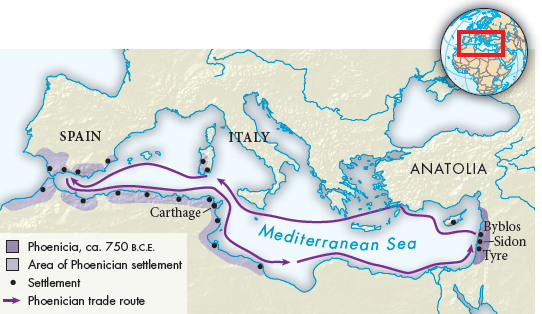The Emergence of New States

The Bronze Age Collapse was a time of massive political and economic disruption, but it was also a period of the spread of new technologies, especially iron. Iron appears to have been smelted in Anatolia as early as 2500 B.C.E., but it was too brittle to be of much use until about 1100 B.C.E., when techniques improved and iron weapons gradually became stronger and cheaper than their bronze counterparts. Thus, in the schema of dividing history into periods according to the main material out of which tools are made (see Chapter 1), the Iron Age began in about 1100 B.C.E. Iron weapons became important items of trade around the Mediterranean and throughout the Tigris and Euphrates Valleys, and the technology for making them traveled as well. (See “Global Trade: Iron.”)
The decline of Egypt allowed new powers to emerge. South of Egypt along the Nile was a region called Nubia, which as early as 2000 B.C.E. served as a conduit of trade through which ivory, gold, ebony, and other products flowed north from sub-
With the contraction of the Egyptian empire, an independent kingdom, Kush, rose to power in Nubia, with its capital at Napata in what is now Sudan. The Kushites conquered southern Egypt, and in 727 B.C.E. the Kushite king Piye (r. ca. 747–
While Kush expanded in the southern Nile Valley, another group rose to prominence along the Mediterranean coast of modern Lebanon. These people established the prosperous commercial centers of Tyre, Sidon, and Byblos, all cities still thriving today. These peoples were master shipbuilders, and from about 1100 B.C.E. to 700 B.C.E. many of the residents of these cities became the seaborne merchants of the Mediterranean. Their most valued products were purple and blue textiles, from which originated their Greek name, Phoenicians, meaning “Purple People.” They also worked bronze and iron, which they shipped processed or as ore, and made and traded glass products. Phoenician ships often carried hundreds of jars of wine, and the Phoenicians introduced grape growing to new regions around the Mediterranean, dramatically increasing the amount of wine available for consumption and trade. They imported rare goods and materials, including hunting dogs, gold, and ivory, from Persia in the east and from their neighbors to the south.
The variety and quality of the Phoenicians’ trade goods generally made them welcome visitors. They established colonies and trading posts throughout the Mediterranean and as far west as the Atlantic coast of modern-

The Phoenicians’ overwhelming cultural achievement was the spread of a completely phonetic system of writing — that is, an alphabet (Figure 2.2). Writers of cuneiform and hieroglyphics had developed signs that were used to represent sounds, but these were always used with a much larger number of ideograms. Sometime around 1800 B.C.E., workers in the Sinai Peninsula, which was under Egyptian control, began to use only phonetic signs to write, with each sign designating one sound. This system vastly simplified writing and reading and spread among common people as a practical means of record keeping and communication. Egyptian scribes and officials continued to use hieroglyphics, but the Phoenicians adapted the simpler system for their own language and spread it around the Mediterranean. The Greeks modified this alphabet for their own language, and the Romans later based their alphabet — the script we use to write English today — on Greek. Alphabets based on the Phoenician alphabet were also created in the Persian Empire and formed the basis of Hebrew, Arabic, and various alphabets of South and Central Asia. The system invented by ordinary people and spread by Phoenician merchants is the origin of most of the world’s phonetic alphabets in use today.
